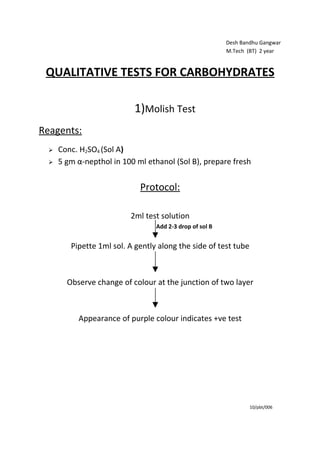
DESH BANDHU GANGWAR, Carbohydrate
- 1. Desh Bandhu Gangwar M.Tech (BT) 2 year QUALITATIVE TESTS FOR CARBOHYDRATES 1)Molish Test Reagents: Conc. H2SO4 (Sol A) 5 gm α-nepthol in 100 ml ethanol (Sol B), prepare fresh Protocol: 2ml test solution Add 2-3 drop of sol B Pipette 1ml sol. A gently along the side of test tube Observe change of colour at the junction of two layer Appearance of purple colour indicates +ve test 10/pbt/006
- 2. 2) Anthrone Test Reagents: Conc. H2SO4 (Sol A) 0.2% anthrone solution in con.H2SO4 (Sol B) Protocol: 0.5 to 1 ml test solution Add 2ml of sol B Through mixing Observe change in colour Appearance of bluish green colour +ve test If not, boil in water bath for 10 min Appearance of bluish green colour 10/pbt/006
- 3. 3) Bendict’s Test Reagents: 173 gm. Sodium citrate and 100 gm anhydrous Na2CO3 In 600 ml hot distilled water (Sol A) {bendict’s reagent} 17.3 gm copper sulphate in 100 ml hot distilled water (Sol B) Add sol A and sol B in 1:1, make final vol. 1 lit (sol C) Protocol: 0.5ml test sol Add 2ml of sol C Through mixing Cook in water bath Observe formation of red ppt. Presence of reducing sugar 10/pbt/006
- 4. 4) Picric Acid Test Reagents: 13% picric acid w/v in DW, boil and cool (Sol A) 10% Na2CO3 (Sol B) Protocol: 1 ml test solution Add 1ml of sol A & 0.5 ml of sol B Cook in water bath Observe formation of red colour Presence of Reducing sugar 10/pbt/006
- 5. 5) Bial’s Test Reagents: 1.5 gm orcinol in 100 ml con. Hcl (sol A) 10% Fecl3 solution (sol B) Add 20 to 30 drops of sol B into sol A (sol C) Protocol: 4 to 5 drops of test solution Add 2ml of sol C Cook in water bath Observe formation of bluish colour Presence of carbohydrate 10/pbt/006
- 6. 6) Iodine Test Reagents: 0.005 N I2 in 3% KI (Sol A) Protocol: 0.5 to 1 ml test solution Add 4 to 5 drops of sol A Gentle mixing Observe change in colour 10/pbt/006
- 7. 7) Borfoed’s Test Reagents: 13.3 gm copper acetate in 200 ml DW (sol A) 1.80 ml glacial acetic acid (Sol B) Mix sol A & sol B (barfoed reagent) (sol C) Protocol: 1 ml test solution Add 2ml sol C Cook in boiling water bath Observe formation of brick red colour 10/pbt/006
- 8. 8) Seliwanoff’s Test Reagents: 0.05% w/v resorcinol in 3N HCl (sol A) Protocol: take 1 ml test solution Add 2ml sol A Cook in boiling water bath for 1 min Observe formation of deep red colour Presence of ketose sugar 10/pbt/006
- 9. 9) Fehling’s Test Reagents: 35.0 gm copper sulphate in DW in 500 ml (sol A) 120 gm KOH and 173 gm Na-K tartarate in 500ml water (sol B) Mix sol A+ sol B in 1:1 ratio (sol C) Protocol: take 1 ml of test solution Add 1 ml sol C mix thoroughly Cook in water bath Observe formation of red ppt. Presence of reducing sugar 10/pbt/006
